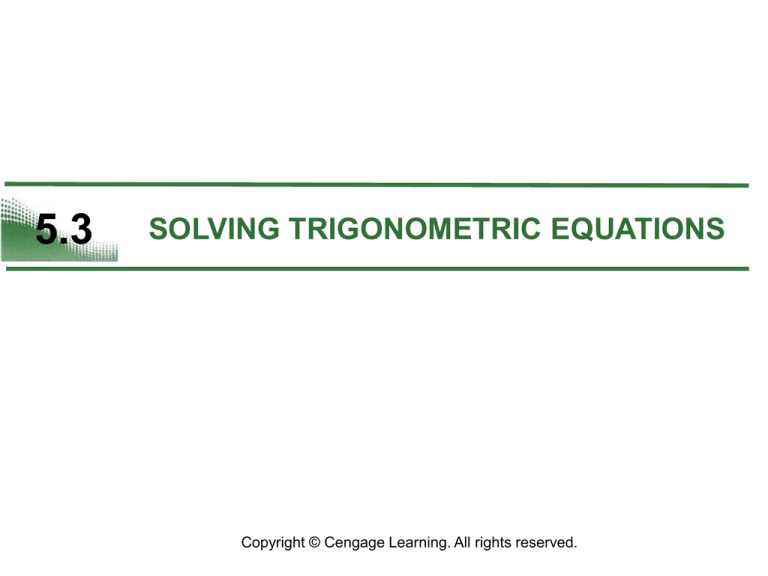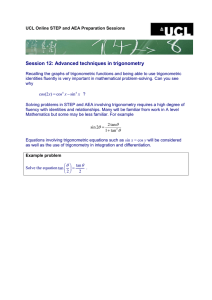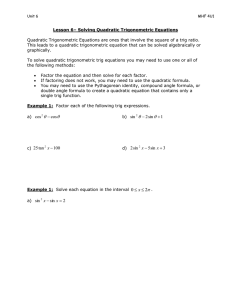
5.3
SOLVING TRIGONOMETRIC EQUATIONS
Copyright © Cengage Learning. All rights reserved.
What You Should Learn
• Use standard algebraic techniques to solve
trigonometric equations.
• Solve trigonometric equations of quadratic type.
• Solve trigonometric equations involving multiple
angles.
• Use inverse trigonometric functions to solve
trigonometric equations.
2
Introduction
3
Introduction
To solve a trigonometric equation, use standard algebraic
techniques such as collecting like terms and factoring.
Your preliminary goal in solving a trigonometric equation is
to isolate the trigonometric function in the equation.
For example, to solve the equation 2 sin x = 1, divide each
side by 2 to obtain
4
Introduction
To solve for x, note in Figure 5.6 that the equation
has solutions x = /6 and x = 5 /6 in the interval [0, 2).
Figure 5.6
5
Introduction
Moreover, because sin x has a period of 2, there are
infinitely many other solutions, which can be written as
and
General solution
where n is an integer, as shown in Figure 5.6.
6
Introduction
Another way to show that the equation
has
infinitely many solutions is indicated in Figure 5.7.
Any angles that are coterminal with /6 or 5 /6 will also be
solutions of the equation.
When solving trigonometric
equations, you should write
your answer(s) using exact
values rather than decimal
approximations.
Figure 5.7
7
Example 1 – Collecting Like Terms
Solve
Solution:
Begin by rewriting the equation so that sin x is isolated on
one side of the equation.
Write original equation.
Add sin x to each side.
Subtract
from each side.
8
Example 1 – Solution
cont’d
Combine like terms.
Divide each side by 2.
Because sin x has a period of 2, first find all solutions in
the interval [0, 2).
These solutions are x = 5 /4 and x = 7 /4. Finally, add
multiples of 2 to each of these solutions to get the general
form
and
General solution
where n is an integer.
9
Equations of Quadratic Type
10
Equations of Quadratic Type
Many trigonometric equations are of quadratic type
ax2 + bx + c = 0. Here are a couple of examples.
Quadratic in sin x
Quadratic in sec x
2 sin2 x – sin x – 1 = 0
sec2 x – 3 sec x – 2 = 0
2(sin x)2 – sin x – 1 = 0
(sec x)2 – 3(sec x) – 2 = 0
To solve equations of this type, factor the quadratic or, if
this is not possible, use the Quadratic Formula.
11
Example 4 – Factoring an Equation of Quadratic Type
Find all solutions of 2 sin2 x – sin x – 1 = 0 in the interval
[0, 2).
Solution:
Begin by treating the equation as a quadratic in sin x and
factoring.
2 sin2 x – sin x – 1 = 0
(2 sin x + 1)(sin x – 1) = 0
Write original equation.
Factor.
12
Example 4 – Solution
cont’d
Setting each factor equal to zero, you obtain the following
solutions in the interval [0, 2).
2 sin x + 1 = 0
and
sin x – 1 = 0
13
Functions Involving Multiple Angles
14
Functions Involving Multiple Angles
The next example involves trigonometric functions of
multiple angles of the forms sin ku and cos ku.
To solve equations of these forms, first solve the equation
for ku, then divide your result by k.
15
Example 7 – Functions of Multiple Angles
Solve 2 cos 3t – 1 = 0.
Solution:
2 cos 3t – 1 = 0
2 cos 3t = 1
Write original equation.
Add 1 to each side.
Divide each side by 2.
16
Example 7 – Solution
cont’d
In the interval [0, 2), you know that 3t = /3 and 3t = 5 /3
are the only solutions, so, in general, you have
and
Dividing these results by 3, you obtain the general solution
and
General solution
where n is an integer.
17
Using Inverse Functions
18
Using Inverse Functions
In the next example, you will see how inverse trigonometric
functions can be used to solve an equation.
19
Example 9 – Using Inverse Functions
Solve sec2 x – 2 tan x = 4.
Solution:
sec2 x – 2 tan x = 4
1 + tan2 x – 2 tan x – 4 = 0
tan2 x – 2 tan x – 3 = 0
(tan x – 3)(tan x + 1) = 0
Write original equation.
Pythagorean identity
Combine like terms.
Factor.
20
Example 9 – Solution
cont’d
Setting each factor equal to zero, you obtain two solutions
in the interval (– /2, /2). [Recall that the range of the
inverse tangent function is (– /2, /2).]
tan x – 3 = 0
and
tan x = 3
tan x + 1 = 0
tan x = –1
x = arctan 3
21
Example 9 – Solution
cont’d
Finally, because tan x has a period of , you obtain the
general solution by adding multiples of
x = arctan 3 + n
and
General solution
where n is an integer.
You can use a calculator to approximate the value of
arctan 3.
22





